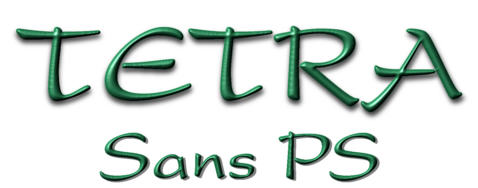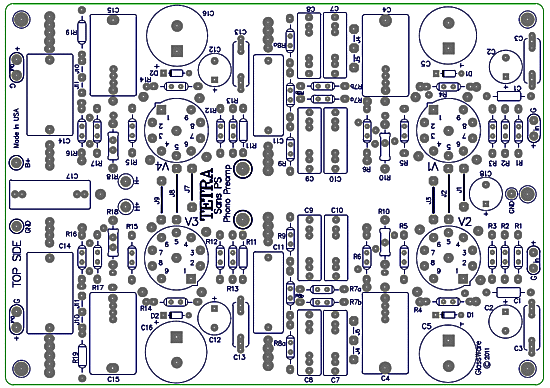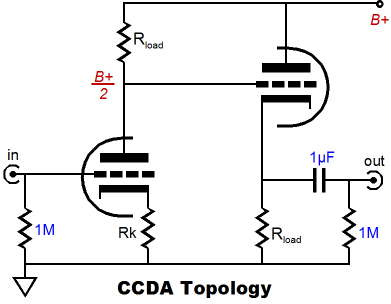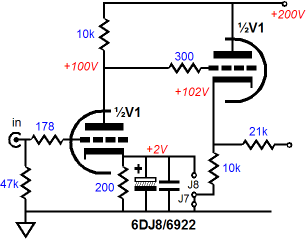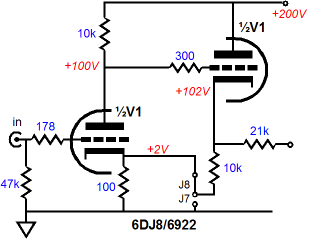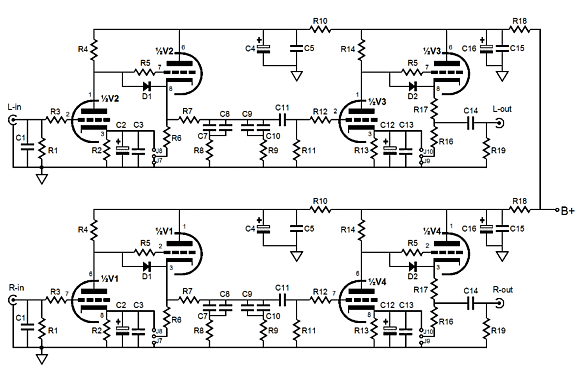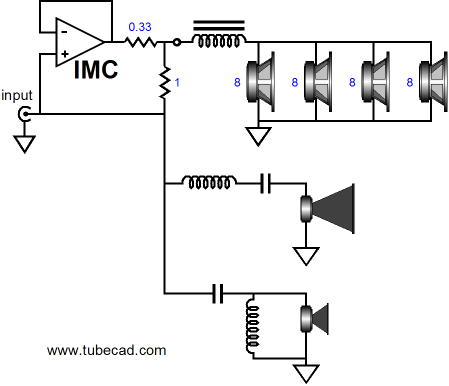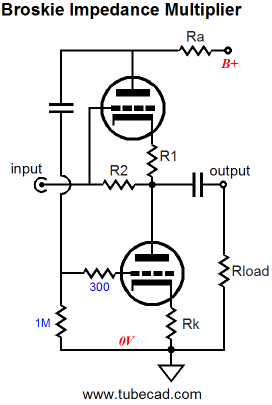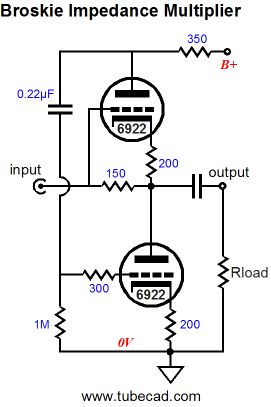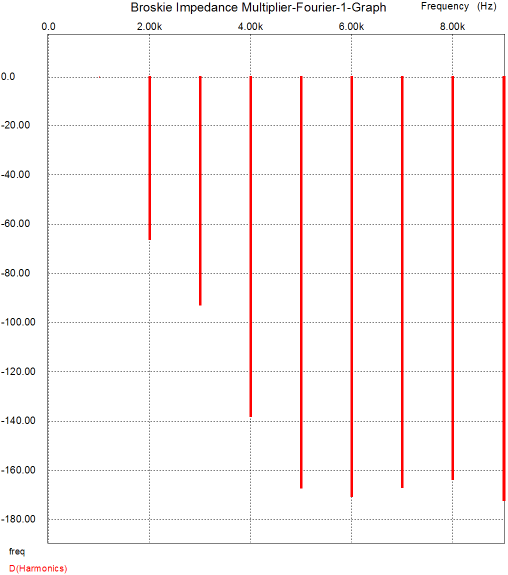| John Broskie's Guide to Tube Circuit Analysis & Design |
24 October 2009
Introducing the Tetra Phono Preamp
CCDA Topology
Calculating the gain from a CCDA amplifier is easy, when the cathode resistor is left un-bypassed, as the gain roughly equals half the mu of the input triode used. For example, a 12AX7 holds a mu of 100, so the gain will equal 50 (+34dB). The gain from a simple grounded-cathode amplifier, with a bypassed cathode resistor, is a bit more complicated Gain = muRa / (rp + Ra) For example, given a 12AX7 loaded by a 150k plate resistor and whose capacitor resistor is bypassed, the gain will roughly equal 70 (+37dB). The passive equalization network entails a -20dB insertion loss, which must be subtracted from the combined gain from the two CCDA gain stages. For example, two 12AX7-based, +34dB gain stages deliver a final gain of +68dB -20dB, which equals +48dB. Of course, the cathode followers also exact a slight loss of gain, so in the example just given, the final gain would be closer to +44 to 46dB.
Alternate Cathode Resistor Connection
The first is to use jumper J7 (and J9 for the final CCDA gain stage) and capacitors C2 & C3. This the standard way that 99.99999% of tube circuits are wired.
The second approach is to use jumper J8 (and J10 for the final CCDA gain stage) and forgo the bypass capacitors. This configuration requires halving the cathode resistor’s nominal value, as twice the current will flow through the resistor. The resistor is effectively bypassed, however, as anti-phase AC current flows from the cathode follower side of the circuit into the cathode resistor, effectively establishing a DC current flow and constant voltage drop across the resistor. (In reality, a small amount of AC current signal will superimpose a small AC signal across the resistor.) Just as we can wear a belt with suspenders, the bypass capacitors can be added to this configuration. But do first try it without the capacitors. I have become quite senstive to the sonic overlay that cathode resistor bypass capacitor adds to the sound from a circuit.
Tetra PCB They cost $49 USD—a great bargin, in other words. Additional parts for the Tetra, such as tube sockets, tubes, and power-supply parts, are also available at the GlassWare Yahoo store.
Broskie Impedance Multiplier Imagine a class-D amplifier configured as an IMC and four 8-ohm long-throw, low resonance, low efficiency woofers in parallel. Quadrupling the woofer surface area will result in +12dB increase in efficiency, if all the drivers see the same voltage across their leads. Thus, if we start with 88dB woofers, we effectively end up with a 100dB woofer that can move four times more air, providing much deeper and powerful bass performance than we would expect from a relatively small enclosure. Our wimpy tube amplifier could never drive the 2-ohm load directly, but with the aid of the high-power IMC, it does not have to. By the way, a 2-ohm load is great news for the series inductor used in the woofer’s crossover, as it need only be one fourth the value that an 8-ohm woofer would otherwise require.
Yes, a passive crossover would still be required. Just imagine a fairly small loudspeaker with 100dB efficiency (horn midrange and tweeter) and super-sweet, flea-power, single-ended amplifier, say 2A3 or 300B filled. This is the stuff that dreams are made of.
I have come up with an interesting tube-based IMC, which I shamelessly have named the Broskie Impedance-Multiplier. The circuit offers push-pull impedance multiplying, with top and bottom triodes responding to the AC current signal presented at its input. Once again, start by imagining a load of 0-ohms, a dead short to ground, in other words. A positive-going input current will develop a positive-going input voltage for the top triode, which will increase its conduction, thereby creating a negative-going input signal for the bottom triode’s grid, which will decrease its conduction. A negative-going input current will develop a negative-going input voltage for the top triode, which will decrease its conduction, thereby creating a positive-going input signal for the bottom triode’s grid, which will decrease its conduction. In a nutshell, push-pull operation; the delta in currents between top and bottom tubes will flow into and out of the ground connection. Yes, I know it looks a lot like a White cathode follower, but it doesn’t function like one. First, unlike with a White cathode follower, the input and output are not independent of the signal source and load impedance. For example, with the 0-ohm load, the Broskie impedance multiplier’s input impedance will equal resistor R2’s value, hardly the near infinite input impedance that the White cathode follower presents. And a high-impedance signal source will yield a high output impedance from the impedance multiplier, not the constantly low impedance offered by the White cathode follower. Remember, an IMC is not a unity-gain buffer or a voltage amplifier; it is something altogether different.
The above schematic reveals a design example that uses a 6DJ8/6922/ECC88/6N23P/6N11 type tube and provides symmetrical current swings from both triodes into the load and multiplies the load impedance by roughly 2. The following graph is from a SPICE simulation with a 1Vpk swing into 300-ohm load at 1kHz.
//JRB |
E-mail from GlassWare Customers
High-quality, double-sided, extra thick, 2-oz traces, plated-through holes, dual sets of resistor pads and pads for two coupling capacitors. Stereo and mono, octal and 9-pin printed circuit boards available. Aikido PCBs for as little as $24 http://glass-ware.stores.yahoo.net/
Support the Tube CAD Journal & get an extremely powerful push-pull tube-amplifier simulator for TCJ Push-Pull Calculator
TCJ PPC Version 2 Improvements Rebuilt simulation engine *User definable
Download or CD ROM For more information, please visit our Web site : To purchase, please visit our Yahoo Store: |
|||
| www.tubecad.com Copyright © 1999-2009 GlassWare All Rights Reserved |
